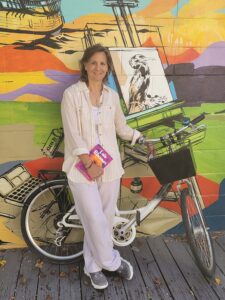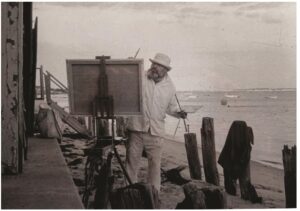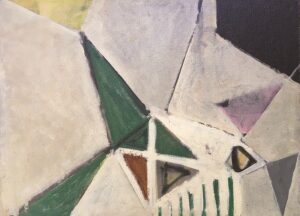Calexico Brings Desert Vibes to the Outer Cape
The style of Tuscon, Ariz.-based indie rock band Calexico has been described as “desert noir” — their music is inspired by the dry desert landscapes that are so conducive to evocative storytelling. Guitarist and singer Joey Burns and drummer John Convertino first played together in 1990 as part of the band Giant Sand. Since then, the two main members of Calexico (named for the border town of Calexico, Calif.) have released 12 albums with a rotating ensemble of accompanying musicians.

Calexico will make its debut at Payomet Performing Arts Center (29 Old Dewline Road, North Truro) on Friday, Aug. 18 at 7 p.m. The concert will feature a full performance of their 2003 album Feast of Wire on the occasion of the 20th anniversary of its release, as well as other songs from the band’s repertoire.
Influenced partly by traditional Latin music as well as by the sounds of country, jazz, and post-rock, Calexico’s songs are uniquely mystical and consistently compelling. The tracks on Feast of Wire tell stories in which the subjects are escaping trouble or are desperately stuck. In one, a ruined village is reborn; in another, migrants in the shadows dodge the law. The lyrics describe hard times, while the instrumentals are marked by ethereal melodies, punctuated rhythms, and forward motion.
Tickets are $38 to $60, plus fees, at tickets.payomet.org. —Dorothea Samaha
Drew Sebastian Brings ‘Dad’s Cabaret’ to Town
When Drew Sebastian, who is bringing his “Dad’s Cabaret” to Pilgrim House (336 Commercial St., Provincetown) for 10 shows, was growing up in Knoxville, Tenn., his mother kept Elvis and Ella spinning on the record player.

That early exposure gave Sebastian a leg up on learning to swivel his hips and belt out tunes from the Great American Songbook. Since Presley and Fitzgerald were also considered gateway singers to the sinful world of jazz, it isn’t surprising that Sebastian picked up the “devil’s horn” along the road to hell, or Dollywood, where he earned his professional stripes hoofing and crooning through a theme park country-Western revue before putting aside his burgeoning musical theater career for a stint in the adult film industry.
During the pandemic, this self-professed “band nerd” joined an orchestra of retired professional musicians in the California desert, and by the time the masks came off Sebastian was performing his new solo show for enthusiastic crowds in Palm Springs.
Sebastian is a familiar face to many in Provincetown. He was a chef at the much-missed 141 Bradford grocery store and deli (now home to the Provincetown Brewing Co.) He’s also been a private chef for many celebrities in Hollywood, although the Independent was not able to break through his wall of discretion to find out what movie stars have late-night cravings for fish sticks.
Although Sebastian’s cabaret show will feature jazz and classic crooner songs, he wants you to know that it isn’t highbrow. But even if stories about his work as an adult performer do pop up in the show, it still promises to be a class act.
Tickets for the show are $35 ($45 for V.I.P. seating) at pilgrimhouseptown.com. —James Judd
Embracing the ‘Messiness’ of Coming Out at Midlife

Melissa Giberson, an occupational therapist by training, did not expect her life to take the turns that it has.
“I call myself an accidental author,” says Giberson, whose memoir Late Bloomer: Finding My Authentic Self at Midlife was released on Aug. 8. Giberson will launch it officially at the Commons (46 Bradford St., Provincetown) on Monday, Aug. 21 at 3 p.m., where she will sign copies and discuss the book with author Richard C. Morais.
Giberson’s memoir tells the story of realizing she was gay while she was married to a man and planning her daughter’s bat mitzvah. It “lays out the story in all its messiness,” Giberson says. What began as confusion and an “existential crisis” paved the way to deep-seated grief: “I didn’t even realize I was grieving — and you do, for the life you thought you’d have,” she says.

There was joy, too, for Giberson, who first came to Provincetown from her home in Wayne, N.J. because she knew it was a queer mecca and “immediately fell in love with this town.” She and her partner of 10 years are now looking to move here full-time.
The raw and conflicting emotions in Late Bloomer make for an intrepid approach to exposing personal truth. Giberson’s hope for the memoir is that it reaches others at a time when they need the guidance that she once sought.
“I did a lot of healing through writing it,” Giberson says, adding that she hopes it lends clarity and healing to others, too. She will also discuss the book in a talk at the Wellfleet Public Library on Tuesday, Aug. 29 at 7 p.m. See provincetowncommons.org and wellfleetlibrary.org for more information. —Sophie Mann-Shafir
Celebrating Paul Resika at Berta Walker Gallery

Few figures occupy as prominent a position in Provincetown’s cultural firmament as Paul Resika. Along with his contemporaries Salvatore Del Deo and Robert Henry, Resika is among the last of the generation of visual artists who confirmed the Outer Cape as an important focal point for American painting in the last half of the 20th century.

Like Del Deo and Henry, who respectively turned 95 and 90 earlier this month, Resika is celebrating a milestone this summer. To mark Resika’s 95th birthday on Aug. 15, Berta Walker Gallery (208 Bradford St., Provincetown) is mounting a retrospective exhibition of his paintings of Provincetown, made from his arrival in town in 1947 to the present day.

The more than three dozen works in the exhibition provide a broad overview of Resika’s subjects and ideas over the last seven decades. It’s also useful for tracing his many stylistic paths and ideas to see how he arrived at his most recent body of work.
Provincetown Still Life, an oil on canvas study from 1947, is one of the paintings most clearly influenced by the currents of Abstract Expressionism that were prevalent when the teenage Resika came to Provincetown to paint in the studio of Hans Hofmann. The composition of geometric shapes is less a representation of objects in space as it is an exercise in color values and formal relationships.

More contemporary works show Resika gradually reducing the elements of landscape painting to the essentials: shape and color. Like the earlier still life, Celadon Sea uses simple geometric shapes to depict a complex reality. The more recent Veronese — just a circle and rectangle set against an expanse of delicately modulated solid color — reduces the components even further. In both works, unexpected juxtapositions of color and tonality add a metaphysical dimension to Resika’s depiction of the natural world.
Works by Rob DuToit and Brenda Horowitz are also currently on display in the gallery. The exhibitions are on view until Sept. 3. See bertawalkergallery.com. —John D’Addario



